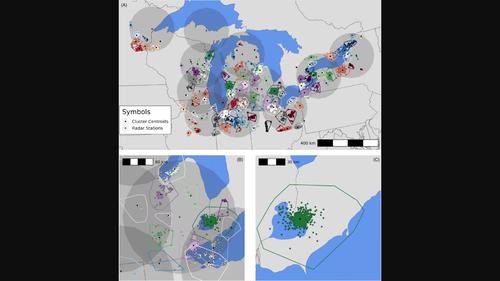Long‐term analysis of persistence and size of swallow and martin roosts in the US Great Lakes
IF 3.9
2区 环境科学与生态学
Q1 ECOLOGY
引用次数: 4
Abstract
In this study, we combined a machine learning pipeline and human supervision to identify and label swallow and martin roost locations on data captured from 2000 to 2020 by 12 Weather Surveillance Radars in the Great Lakes region of the US. We employed radar theory to extract the number of birds in each roost detected by our technique. With these data, we set out to investigate whether roosts formed consistently in the same geographic area over two decades and whether consistency was also predictive of roost size. We used a clustering algorithm to group individual roost locations into 104 high‐density regions and extracted the number of years when each of these regions was used by birds to roost. In addition, we calculated the overall population size and analyzed the daily roost size distributions. Our results support the hypothesis that more persistent roosts are also gathering more birds, but we found that on average, most individuals congregate in roosts of smaller size. Given the concentrations and consistency of roosting of swallows and martins in specific areas throughout the Great Lakes, future changes in these patterns should be monitored because they may have important ecosystem and conservation implications.

美国五大湖燕子和马丁栖息地持续性和大小的长期分析
在这项研究中,我们将机器学习管道和人类监督相结合,根据2000年至2020年美国五大湖地区12个天气监测雷达采集的数据,识别和标记燕子和马丁的栖息地。我们利用雷达理论提取了我们的技术检测到的每个栖息地的鸟类数量。有了这些数据,我们开始调查20年来栖息地是否在同一地理区域一致形成,以及一致性是否也能预测栖息地的大小。我们使用聚类算法将单个栖息位置分组为104个高密度区域,并提取鸟类使用这些区域栖息的年份。此外,我们还计算了总体种群规模,并分析了每日栖息规模分布。我们的研究结果支持这样一种假设,即更持久的栖息地也会聚集更多的鸟类,但我们发现,平均而言,大多数个体都聚集在较小的栖息地。考虑到燕子和马提尼在整个五大湖特定地区的栖息浓度和一致性,应该监测这些模式未来的变化,因为它们可能会对生态系统和保护产生重要影响。
本文章由计算机程序翻译,如有差异,请以英文原文为准。
求助全文
约1分钟内获得全文
求助全文
来源期刊

Remote Sensing in Ecology and Conservation
Earth and Planetary Sciences-Computers in Earth Sciences
CiteScore
9.80
自引率
5.50%
发文量
69
审稿时长
18 weeks
期刊介绍:
emote Sensing in Ecology and Conservation provides a forum for rapid, peer-reviewed publication of novel, multidisciplinary research at the interface between remote sensing science and ecology and conservation. The journal prioritizes findings that advance the scientific basis of ecology and conservation, promoting the development of remote-sensing based methods relevant to the management of land use and biological systems at all levels, from populations and species to ecosystems and biomes. The journal defines remote sensing in its broadest sense, including data acquisition by hand-held and fixed ground-based sensors, such as camera traps and acoustic recorders, and sensors on airplanes and satellites. The intended journal’s audience includes ecologists, conservation scientists, policy makers, managers of terrestrial and aquatic systems, remote sensing scientists, and students.
Remote Sensing in Ecology and Conservation is a fully open access journal from Wiley and the Zoological Society of London. Remote sensing has enormous potential as to provide information on the state of, and pressures on, biological diversity and ecosystem services, at multiple spatial and temporal scales. This new publication provides a forum for multidisciplinary research in remote sensing science, ecological research and conservation science.
 求助内容:
求助内容: 应助结果提醒方式:
应助结果提醒方式:


